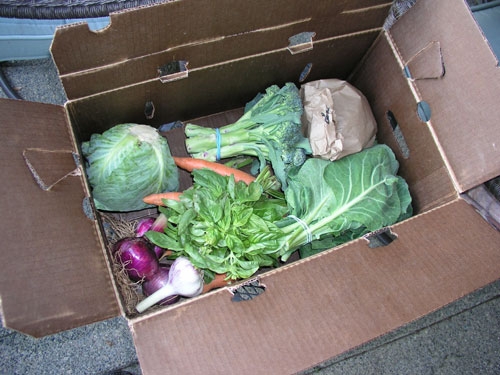Community supported agriculture prospering in Central Valley
Community Supported Agriculture (CSA) – a way of buying fresh produce and other foods directly from farmers – is growing rapidly in California’s Central Valley, according to a newly published study in the California Agriculture journal.
Membership in the CSAs surveyed for the study increased from an estimated 672 in 1990 to 32,938 in 2010.
The growth in Central Valley CSAs is one part of a bigger movement toward stronger direct relationships between farmers and consumers, said Ryan Galt, UC Davis assistant professor in the Department of Human and Community Development and co-author of the study “Community Supported Agriculture is thriving in the Central Valley."
“Consumers increasingly want to connect with the farmers who grow their food,” Galt explained, while unpacking a cornucopia of vegetables from his own CSA box. “Food is an intimate thing, so I don’t think it’s strange that people want to establish relationships with those who produce it.”
While Galt’s study focuses on the farm, rather than consumer, side of the relationship, he said he joined a CSA for several reasons.
“I wanted to support a more ecologically oriented agriculture, and the livelihoods of farmers and farmworkers. And then, there is the benefit of not having to shop as much,” he added, snipping a bunch of deep purple beets from their greens.
It’s beet season in California. The dark root vegetable is relatively new to Galt’s culinary repertoire. Had it not shown up in the first CSA box to which he subscribed, years ago, he might never have learned to prepare it and would unlikely order it on a menu. The surprise and challenge of preparing new, interesting foods is among the reasons Galt still subscribes to a CSA.
Like most California CSA members, Galt picks up a basket of produce from a central location, not necessarily the farm itself. Some CSA farms deliver directly to homes. Few require members to visit the farm, but most host member events.
“CSA farmers provide their members more than food. They offer a direct connection to what is happening on the farm and with the seasons, they educate their members on agricultural and rural issues, and they share recipes that help members use their food,” Galt said, sliding a pot of beets into the oven.
It’s a lucrative exchange for CSA farmers, he adds. Average gross sales per acre for CSA farms is six times greater than average CA farms. Because people subscribe to their farm in the same way people subscribe to magazines, CSA farmers have a good idea how much to produce and harvest, and, most importantly for them, they have a promised market and up-front cash. Many young farmers are creating CSAs because of these benefits.
“CSA farmers are motivated by their love of farming and the satisfaction of providing fresh produce to grateful members,” Galt said.
Roasted beets
6 medium beets
2 tablespoons balsamic vinegar
2 teaspoons orange zest
Pepper
Preheat oven to 350 F. Wash the beets and put the unpeeled in a roasting pan with about an inch of water. Cover and bake for an hour, or until they are easily pierced with a folk. Slip off the skins after the beets have cooled. Slice the beets into wedges. Toss with vinegar, orange zest and pepper. Serve at room temperature.

